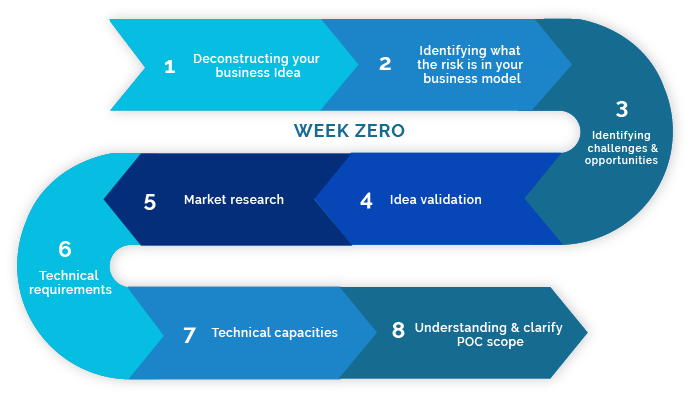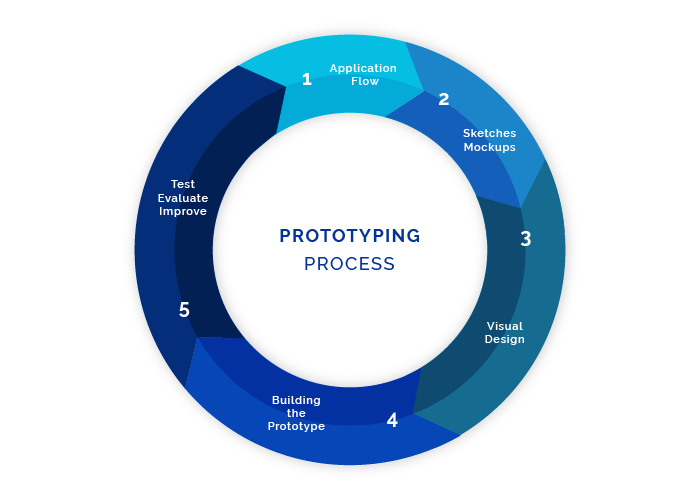Having an idea is just the beginning of every project. To demonstrate its feasibility and practical potential, you’ll need a Proof of Concept. A Proof of Concept (POC) can either be a Prototype without code or an MVP (Minimum Viable Product) with a minimal feature set. The Prototype is needed for the organization-internal decision makers such as the Board of Directors, CEO, or others, who first need to sign off on a project before it starts.
Our Proof of Concept Service is unique. We help you present a potential solution/idea to the decision-makers in your organization to secure further resources for the full development of the product. Decision makers always want to reduce risks, and we understand your need to show the viability of the project with minimal resources. Our expertise will help you prove the viability of your project to decision makers.
Working with you closely, we define a set of requirements necessary to start and build your POC.
 Below are our proof-of-concept stages:
Below are our proof-of-concept stages:
Week Zero
For your idea to become a viable project, you first need to prove the need for it. Whether it is an internal business case which improves productivity or efficiency, or a new product to increase your overall market, the most critical data for your idea at this stage is viability. We help you deconstruct your concept into its main parts first to differentiate the goals/problems of the idea from the solutions. Generally, the two are tangled up. Our structured discussion and brainstorming model helps you understand your idea much better.
We then proceed to validate your goals/problems. Depending on your idea, this can be done by interviewing potential users, stakeholders, investors, partners, etc. Internally we call this the “exploratory surgery stage,” as our primary goal is to find and synthesize patterns in the target groups. More often than not we see that problems overlap, interact, or sometimes aren’t there at all. You can expect that most of your issues hypothesized will be re-defined in this stage, thus reducing the total number of goals/problems significantly.
The second stage pertains to mapping the goals/problems to a possible solution. Through our discussion model, we often find 3-10x more possible solutions per goal/problem than initially thought. Each potential solution is then discussed regarding the organizational specifics, such as market structure, competition, stakeholders, technological challenges, budget, timelines, etc. The result is a spreadsheet which maps our all the project’s goals/problems to all viable solutions and assigns points to each answer. This spreadsheet will be the basis for any further discussion and will help all stakeholders, including the organizational decision makers, understand the reasoning behind the idea. It will also help you determine (with organizational decision makers) what the scope of the project will be without needing an everything-or-nothing approach.
We then interview the same users and stakeholders again and see how they react to specific proposals. Our goal is to be as impartial as possible and collect data. Very often the users will have “aha!” moments and will give us further proposals and comments by themselves. This way we can quickly see how users react to proposed solutions.
The third step is to visually prototype a set of solutions which we (in collaboration with you) deem best. The prototype will be purposefully extremely rudimentary as we fully plan on not reusing any of the prototypes in that state in later stages. Cheap and fast is vital during week 0 so that quality can be addressed during the development stages. These very high-level prototypes will then be tested with users again. Based on their feedback as well as our previously generated solution space spreadsheet, we can narrow down what are the products:
- Feature set
- Business model & case
- UI & UX
All of the above is then compiled into a large folder with all interview transcripts/videos/audio files, written documentation, recorded brainstorming sessions, and prototype design files, as well as a final 1-2 page proposal which can be presented to any organizational decision makers. If need be, we can also include a Time and Cost based development proposal for future steps.
At the end of week Zero, you’ll have a clear theoretical hypothesis ready to be tested.

Prototyping
- Information architecture
- Sketches
- Mockups
- Wireframes
- Visual design
- Actual clickable prototype
- User testing
- Skype calls
If your organizational decision makers want to move forward with code development, the next stage will be a Minimum Viable Product (MVP).

MVP
In this stage, the idea is to create a product with a minimum set of features that is viable enough to test our fundamental assumptions. The reasons why we recommend continuing with an MVP is to be able to prove a product hypothesis with minimal resources and get the product to early adopters as soon as possible. This way we see what they do and don’t like.